This post may contain affiliate links. Please read our disclosure policy.
In-depth turotial on how to make the delicate basic French macaron shells using the French method filled with delicious yam/taro buttercream.

What a journey it has been with me baking these French macarons. I’ve made probably about 20 batches in 2 weeks LOL! Now I understand why French macarons are expensive. I feel like I’ve learned so much just from baking these sensitive temperamental macarons 🙂 But guys, if a lousy baker like me can do French macarons, chances are, you can do it too! Probably do it even better and don’t have to fail dozens of times LOL! I hope what I’ve learned can help you make French macaron successfully too (fingers crossed!) AND don’t give up. I feel like it takes lots of practice to get this little beast correctly! Don’t get discouraged!
You can use carton pasteurized egg white
I have had many successes making macarons using store-bought pasteurized egg whites. Even though the carton has a warning that you cannot use it to make meringue or macarons, my macarons turned out well! I make sure to shake the carton a bit before pouring the egg white out and also to make sure it’s at room temperature. I did not age the egg whites.
Ingredients for French macarons
1. Egg whites
Always weigh your egg white to know the exact amount and make sure it’s at room temperature. I have also used carton egg whites and they worked just fine
2. Super fine almond flour
You still want to process and sift the almond flour even though it says super fine. I still end up with lumps showing on my macaron shells when I only sift and don’t process them into a finer consistency
3. Powdered sugar/icing sugar
4. Caster sugar/fine sugar
If you don’t have caster sugar, you can use granulated sugar and process them in a food processor until it’s a fine consistency
5. Cream of tartar
I won’t suggest replacing cream of tartar with lemon juice or anything liquid. We want to minimize the amount of liquid added into the recipe
6. Pinch of salt
A small pinch of salt makes a huge difference in something sweet like macarons
French Macarons with Taro Buttercream (French Method)
Ingredients
- 64 gr super fine almond flour
- 108 gr icing sugar
- 60 gr egg white (room temperature) see notes
- 46 gr caster sugar
- ¼ tsp cream of tartar see notes
- Small pinch of salt
For coloring (optional):
- Gel food coloring It's important to use gel
Sweet taro buttercream filling (you may have some leftover):
- 120 gr butter unsalted, softened
- 1 Tbsp icing sugar adjust the sweetness to your preference
- 60 gr mashed taro You can also use purple sweet potato
- Purple food coloring optional, for more intense purple color
Instructions
Prepare the filling: (can be done few days before and keep in the fridge)
- Peel and cut the taro into cubes and steam for about 10 minutes or until fork tender. Mash with a fork until smooth
- Make sure the butter is soft. I usually get it out of the fridge 1-2 hours before planning to make the buttercream. Beat the butter using a paddle attachment (if using stand mixer) until creamy and pale, about 2-3 minutes. Then add the mashed taro, the icing sugar, and food coloring (if using) and beat until combined. Store it in the fridge if you don't need it right away. They harden in the fridge. Simply get it out from the fridge 30 minutes before you plan to use to let it soften
Things to prepare and to take notes of:
- Preheat the oven to 325 F (165 C) for a conventional oven. For a convection oven, preheat at 300 F (150 C). If you want to try drying macaron in the oven, then don't preheat the oven yet. Read about drying in the oven at the step below, "Oven Drying"
- Please make sure your oven temperature is accurate. My oven is actually 20 degrees lower than what shows on the display. So I get an oven thermometer to make sure the temperature inside the oven is accurate and I finally get good macarons without overbaking or underbaking
- Some people will age the egg whites in the fridge for 2-3 days before making macarons. I've tried aging and without and I don't see much difference. So, I'm sticking with not aging the egg white. I just bring the egg whites to room temperature, by putting it on the counter for an hour or so. This depends on how warm where you are, it may not even need to be that long. If you are short on time, I have put the bowl of egg white on top of a hot water bath to bring it to room temperature quickly
- Don't use dark-colored baking sheet. My macarons cracked whenever I do this. It didn't work for me. I use high-quality anodized aluminum baking sheet
- Invert your baking sheet upside down. This will give you a baking sheet without the rim. This is another game-changer for me. The macarons baked evenly without the rim. Line the baking sheet with parchment paper. I don't have a silpat, so I use parchment paper. DO NOT use wax paper. Put the template you make underneath the parchment paper ready for you to pipe the batter later. If you use silpat that already has the macaron template, then you can skip this step
- If you want to be consistent with the size, use a bottle cap that is about 1.5 inch in diameter or print a macaron template out for 1.5-inch macaron
- Prepare a piping bag fitted with 1/4-inch nozzle. Put this piping bag inside a bowl or cup to support it so it's easier for you to pour the batter in later
- Make sure your mixing bowl and whisk attachment is squeaky clean. Wipe with some vinegar if necessary to make sure they are grease-free. Your meringue will not whip up well if there is any trace of grease
Prepare the almond flour and sugar:
- I don't have a caster sugar (super-fine sugar), so I put granulated sugar in a food processor and pulse it a few times until it's fine, but don't turn it into powder. Set aside to be used to whip the meringue later
- Even though I get a super-fine almond flour, it is still necessary to make them finer and smoother. Put almond flour and icing sugar in a food processor and pulse for 6 seconds about 6 times or so until they are fine, but don't overdo it or the almond flour will turn into a paste because the fat will release from the almond
Prepare the macaron batter:
- Put the egg white in a mixing bowl or the bowl of the stand mixer fitted with a whisk attachment. Start whipping at speed 4 until it turns foamy with small fine bubbles. Add the small pinch of cream of tartar and whip for another minute. Increase the speed to 6 (don't crank up speed higher than this) and add 1/3 of the sugar and whip for another 1-2 minutes before adding the next. Stop halfway to check the consistency. Whip until soft peak, meaning, when you lift the whisk up, the meringue will bent and still soft. If you want to add any color, add it here at this stage. Continue whipping until you reach a really stiff peak
How to check for really stiff peak:
- When you lift the whisk up, the meringue has short pointy tips. It may bent a bit on the tip, but it shouldn't move. When you invert the bowl upside down, it won't drop or move. You will see the meringue ball up slightly inside the whisk. You want to stop beating at this point. Any further will be overwhipping already
Combine almond flour with meringue:
- Sift in the almond flour mixture (yes, I know..again, lots of sifting here) into the meringue. Use a rubber spatula to do the cut several times and fold over motion as you rotate the bowl to mix the almond flour and meringue until they form thick batter. Stop mixing once you don't see anymore flour mixture
Macaronage: (THE most important stage)
- The purpose of macaronage is to get rid of the large air bubbles and to make the batter smooth and shiny to a flowy pipeable consistency. You want to do macaronage slowly. Do not rush this process. Start by using your spatula to press the batter against the wall of your bowl, spreading it like a flower as you rotate the bowl. This video is a good one to watch on how to do macaronage properly with a spatula.
- Then use your spatula to gather the dough back again and you may need to spread it one more time. How many time you want to press the batter against the wall really depends on the stiffness of your meringue. The stiffer it is, the longer you need to do macaronage and vice versa. So, you really need to observe the batter closely. If you use carton egg white, it’s very easy to overdoing the macaronage
- After that you don’t want to do anymore spreading, start folding. Use your spatula to scoop down, make sure to touch the bottom of the bowl and fold over. Do that 2-3 times and then check the consistency at the same time. In this photo you can see that the batter is still too thick that it doesn’t even drop down. So mix it around once or twice and check again
How to check for macaronage (super important):
- Lift a good amount of the batter up with your spatula and it should flow down very slowly and continuously like thick lava, folding on itself like a staircase. The edge of the ribbon will slowly blend into the batter in about 20-30 seconds. Remember, it needs to flow down SLOWLY and continuously (again, watch this video, she’s a pro!) Stop mixing. If you can write figure "8", you have OVERMIXED! Everyone keeps saying you need to reach figure 8, and I find that quite misleading, at least in my case after baking TONS of macaron for more than a year! Keep in mind that we will transfer this batter into a piping bag and this will “thin” out the batter a bit more. So don’t overmix the batter. If you do, you can be assured to get some hollow shells!
Transfer to a piping bag:
- Scrape this batter down into a piping bag. It will flow like a thick lava. Push out as much air as possible
Pipe the batter:
- Use your dominant hand to hold the top of the piping bag and the other hand to stabilize the bag near the piping tip. Make sure the piping bag is straight, perpendicular to the baking sheet. Don't pipe at an angle. Gently squeeze the batter out and it will slowly spread. Pipe until just about 1/8-inch before the line. The batter will spread to fill up the space later. You may notice some pointy tips (nipple) on the piped macaron, but this will go away when you rap the baking sheets several times later
- Once you are done with piping. Carefully retrieve and pull the template out from underneath the parchment paper. Dab small amounts of macaron batter to seal the 4 corners of the parchment paper so it stays in place
Pop out any air bubbles:
- Pick up the baking sheet and rap it against the counter top 6-8 times (or as many times as it needs) to pop any bubbles. Rap it HARD! Don't be gentle about it! My kids know I'm making macarons when I bang the tray so hard LOL! You will see some bubbles come to the surface. Use a toothpick to gently pop those bubbles
- If you want to add sprinkles, add them now when they are still wet. No heavy sprinkles though. They will crack the shells
Air-dry the macaron shell:
- Let the macaron shells dry. This can take from 15 minutes to 1 hour or longer, depending on humidity. I have a ceiling fan and I put the macaron tray and let them air dry. It helps to speed up the drying process. The ceiling fan is perfect because it's quite far from the macaron, so it's not blowing directly on the macaron. It took about 20-25 minutes for the shells to dry (humidity was about 50% – cloudy day that day, but not too humid)
- When you touch the edge, it should be dry. Also check the center. When you gently touch the center, it should be dry too. The shells would look dull and not shiny anymore. This means they are ready to be baked. If you bake them before a skin form, they will crack in the oven
Oven-dry the macaron shells:
- If humidity is really bad where you are and take your hours just to dry, you can try using your oven "bread proof" function, if there's one. The temperature usually about 90-95 F and if you turn the light on, it may be a bit warmer. Put the tray in there with the door slightly open and let them dry until they form skins, can take about 15 minutes or longer. Don't go by the time, but observe
- Preheat the oven to 350 F (180 C) for a conventional oven. For a convection oven, preheat to 325 F (165 C). I put my oven thermometer in too. I like to preheat it for at least 30 minutes.
Baking:
- Place the baking sheet on the 3rd rack from top. Lower the oven temperature to 325 F (165 C) for conventional, 300 F (150 C) for convection. Bake for 12-13 minutes. Don't open the oven door during this baking time.
- Once the timer is up, check on the macarons by touching the shell and see if they are still wiggly when you try to move them or soft on top. If they are, continue baking for 1 more minute and check again. I need 13 minutes for 1.5" inch shell
Cooling:
- Remove from the oven and let them cool down on the baking sheet set on a cooling rack for at least 15-30 minutes
- After that you can gently peel the parchment away from the shell. Don't pull the shell from the paper as you may rip the base of the macarons. You can put them in the freezer for 10 minutes (after they are no longer warm) and they will peel right off after that. Some may feel still a tiny bit sticky, you can gently use an offset spatula to help you release. It shouldn't be super sticky, just need a little nudging and it should come off. If it's still very sticky, the shells are apparently, underbaked
Fill the shells:
- Transfer the taro cream filling into a piping bag fitted with a round (Wilton 2A) or open star tip (Wilton 4B). Pair the shells together, try to find ones of similar size
- Start piping the filling on one shell and then top with another shell
Age the macaron:
- Transfer the macaron sandwich into a container with a tight-fitting lid. They taste the best after you age them in the fridge for at least 24 hours
How to store assembled macarons in the fridge:
- Assembled macarons can be kept in the fridge for 3 days. Anything longer and the shells will start to get soggy
How to store assembled macarons in the freezer:
- For longer storage, you can freeze them. Depending on the fillings, some don't freeze well, such as filling with jellies. For these type, you want to freeze just the shells and assemble the macarons the day before you want them to be served so they have time to age in the fridge
- After aging the macarons in the fridge for 24 hours. I transfer them to a baking sheet lined with a parchment and put the macarons there to let them freeze for about 30 minutes and then transfer to a container, you can stack them up and kept in the freezer for 1 month
- Simply remove them from the freezer at least 30 minutes before you plan to serve them. Let them thaw at room temperature. Only take out as many as you want to serve and keep the rest frozen until you need them
How to store macaron shells in the freezer:
- Unassembled macaron shells can be kept in the freezer for up to 3 months. Simply put them in a container to prevent breakage. When ready to serve them, simply remove from the freezer the day before you plan to serve them, you don't need to thaw and then fill them up with the filling of your choice and age in the fridge for 24 hours
RECOMMEDED TOOLS
Marv’s Recipe Notes
- Don’t use lemon juice or vinegar to replace cream of tartar when making French macarons. We want as little liquid as possible in our meringue batter
- I have had many successes making macarons with the French method using store-bought pasteurized egg white. However, if it’s your first time making macaron, I recommend using regular fresh egg whites. It’s very easy to over macaronage when you use carton egg whites and whipping the meringue to stiff consistency also takes longer. So, you want to get the hang of how to do proper macaronage and whipping meringue to the correct consistency before using carton egg white IMHO
*Nutrition facts are just estimates and calculated using online tools*
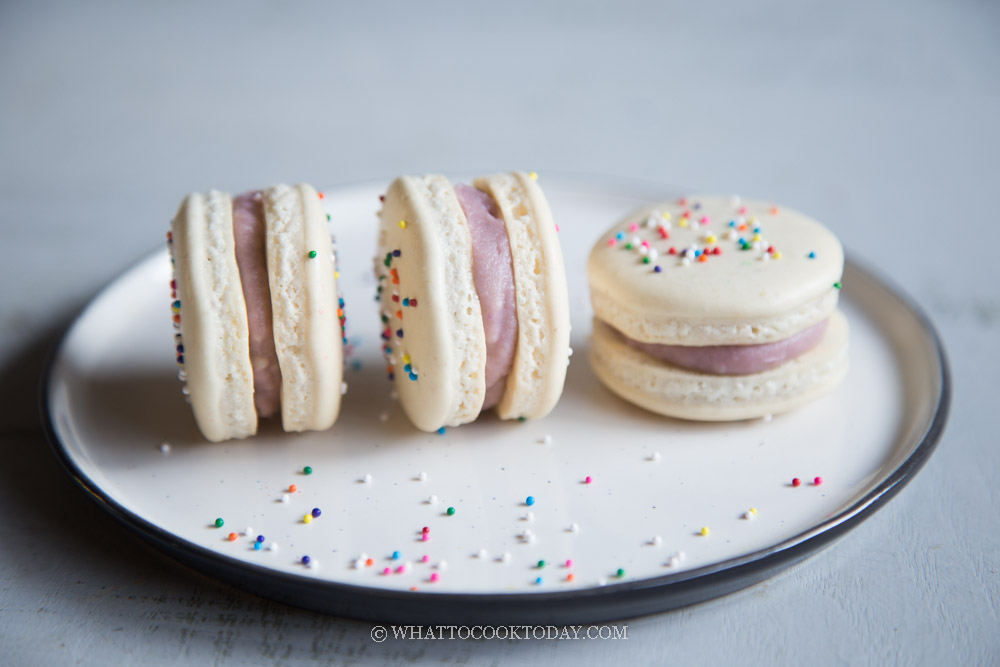
How to make French macaron shells using the French method
Please note that I used different photos accumulated from the times I had made these macarons like zillion of time. So you may see macarons in different colors.
1. Process the almond flour: Even though I get a super-fine almond flour, it is still necessary to make them finer and smoother. Put almond flour in a food processor and process for about 10-15 seconds until they are fine, but don’t overdo it or the almond flour will turn into a paste because the fat will release from the almond
2. Sift the almond flour with icing sugar into a mixing bowl and set aside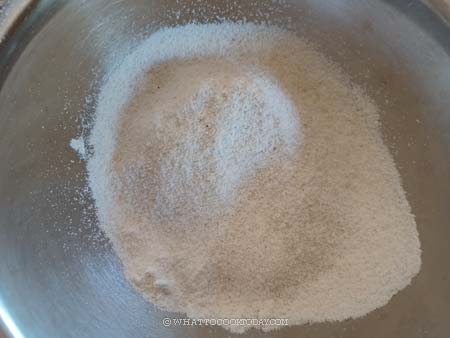
3. Prepare meringue: Put the egg white in a mixing bowl or the bowl of the stand mixer fitted with a whisk attachment. Start whipping at speed 4 until it turns foamy with small fine bubbles. Add the small pinch of cream of tartar and whip for another minute. Increase the speed to 6 (don’t crank up speed higher than this) and add 1/3 of the sugar and whip for another 1-2 minutes before adding the next. Stop halfway to check the consistency. Whip until soft peak, meaning, when you lift the whisk up, the meringue will bent and still soft. If you want to add any color, add it here at this stage. Continue whipping until you reach a really stiff peak.
When you lift the whisk up, the meringue has short pointy tips. It shouldn’t move. When you invert the bowl upside down, it won’t drop or move. You will see the meringue ball up slightly inside the whisk. You want to stop beating at this point. Any further will be overwhipping already
4. Combine flour with meringue: Sift in the almond flour mixture (yes, I know..again, lots of sifting here) into the meringue. Use a spatula to do the cut and mix motion to mix the almond flour and meringue until they form a thick batter. As long as you don’t see anymore flour mixture, stop mixing
5. How to do macaronage: The purpose of macaronage is to get rid of the large air bubbles and to make the batter smooth and shiny to a flowy pipeable consistency.
You want to do macaronage slowly. Do not rush this process. Start by using your spatula to press the batter against the wall of your bowl, spreading it like a flower as you rotate the bowl. This video is a good one to watch on how to do macaronage properly with a spatula.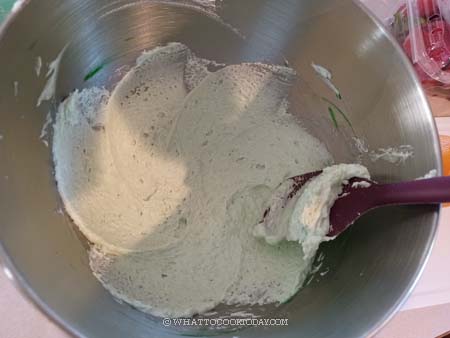
Then use your spatula to gather the dough back again and you may need to spread it one more time. How many time you want to press the batter against the wall really depends on the stiffness of your meringue. The stiffer it is, the longer you need to do macaronage and vice versa. So, you really need to observe the batter closely. If you use carton egg white, it’s very easy to overdoing the macaronage.
6. After that you don’t want to do anymore spreading, start folding. Use your spatula to scoop down, make sure to touch the bottom of the bowl and fold over. Do that 2-3 times and then check the consistency at the same time. In this photo you can see that the batter is still too thick that it doesn’t even drop down. So mix it around for once or twice and check again
7. Lift a good amount of the batter up with your spatula and it should flow down very slowly like thick lava without breaking, folding on itself like a staircase. Remember, it needs to flow down SLOWLY. I used to do the figure “8” to test, but I finally figure out that if I’ve reached that figure 8 stage, it has overmixed for me. Took me one year to figure that out! (again, watch this video, she’s a pro!) Stop mixing. Keep in mind that we will transfer this batter into a piping bag and this will “thin” out the batter a bit more. So don’t overmix the batter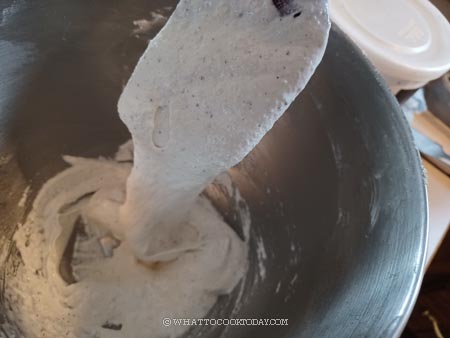
8. Piping: Scrape this batter down into a piping bag. It will flow like thick lava. Push out as much air as possible. Use your dominant hand to hold the top of the piping bag and the other hand to stabilize the bag near the piping tip. Make sure the piping bag is straight, perpendicular to the baking sheet. Don’t pipe at an angle. Gently squeeze the batter out and it will slowly spread. Pipe until just about 1/8-inch before the line. The batter will spread to fill up the space later
9. Once you are done with piping. Carefully retrieve and pull the template out from underneath the parchment paper. Dab small amounts of macaron batter to seal the 4 corners of the parchment paper so it stays in place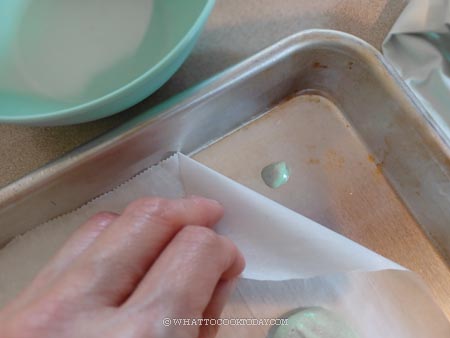
10. Pick up the baking sheet and rap it against the counter top 5-6 times, sometimes even more than that, to pop any bubbles. Rap it HARD! Don’t be gentle about it! My kids know I’m making macarons when I bang the tray so hard LOL! You will see some bubbles come to the surface. Use a toothpick to gently pop those bubbles
11. Preheat the oven to 350 F (180 C) for a conventional oven. For a convection oven, preheat to 325 F (165 C). I put my oven thermometer in too. I like to preheat it for at least 30 minutes. Let the macaron shells dry. This can take from 15 minutes to 1 hour or longer, depending on humidity. I have a ceiling fan and I put the macaron tray and let them air dry. It helps to speed up the drying process. The ceiling fan is perfect because it’s quite far from the macaron, so it’s not blowing directly on the macaron. It took about 20-25 minutes for the shells to dry (humidity was about 50% – cloudy day that day, but not too humid)
12. When you touch the edge, it should be dry. Also check the center. When you gently touch the center, it should be dry too. The shells would look dull and not shiny anymore. This means they are ready to be baked. If you bake them before a skin form, they will crack in the oven
13. Place the baking sheet on the 3rd rack from top. Lower the oven temperature to 325 F (165 C) for conventional, 300 F (150 C) for convection. Bake for 12-13 minutes. Don’t open the oven door during this baking time.
13. Once the timer is up, check on the macarons by touching the shell and see if they are still wiggly when you try to move them or soft on top. If they are, continue baking for 1 more minute and check again. I need 13 minutes for 1.5″ inch shell. You want to bake until they no longer move when you touch them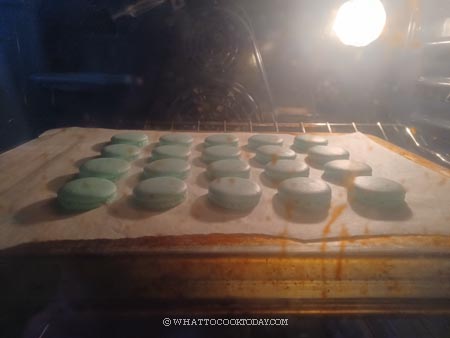
14. Remove from the oven and let them cool down on the baking sheet set on a cooling rack for at least 10-15 minutes. After that you can gently peel the parchment away from the shell. Don’t pull the shell from the paper as you may rip the base of the macarons. You can put them in the freezer for 10 minutes (after they are no longer warm) and they will peel right off after that. Some may feel still a tiny bit sticky, you can gently use an offset spatula to help you release. It shouldn’t be super sticky, just needs a little nudging and it should come off. If it’s still very sticky, the shells are apparently, underbaked
15. Assemble the macarons: Transfer the taro cream filling into a piping bag fitted with a round (Wilton 2A) or open star tip (Wilton 4B). Pair the shells together, try to find ones with similar size
Start piping the filling on one shell and then top with another shell
Tips for success
1. Use a digital kitchen scale
Accuracy is highly important when it comes to making French macarons. I would not depend on cup or tablespoon measurement for this delicate pastry
2. DO NOT cut down on sugar
You want to follow the recipe exactly. You can cut down on sugar with the filling, but NOT with the recipe for macaron shells.
3. Egg whites at room temperature
You can use regular egg whites or carton pasteurized egg whites. For beginner, I recommend using fresh egg white instead of carton egg whites. It’s very easy to over-macaronage with carton egg whites. Both work for me. I don’t age my egg whites too. You are welcome to do so if you want to. I just let the egg whites sit at room temperature for about an hour before I start working on the recipe
4. Process the almond flour and sift
Even though I bought a superfine almond flour, I still process them in a food processor for 10 seconds or so and then sift to remove lumps
5. Beat the meringue until REALLY stiff. You’ll be surprised by how stiff a meringue can get
6. Make sure you get to the macaronage stage, which is a thick flowy batter that flows down SLOWLY without breaking if you lift the batter up. Like a thick lava that fold itself as it flows down (like a staircase) and the edge will blur out in about 20-30 seconds. So the batter is flowy but still quite thick
7. Start preheating the oven before you start on the project. Make sure your internal oven temperature is accurate. I use oven thermometer to make sure it’s accurate
8. Do not try to peel the macarons off the parchment paper when they just come out from the oven. Let them cool down for at least 15 minutes and then peel the paper away from the macarons instead of pulling the macarons from the paper

Common problems with French macarons and how to fix them
1. Hollow macaron shells
These were the problem I encountered batches after batches of baking macarons. They look pretty and with perfect feet and all, but the inside had some hollows. There could be several causes:
The cause: Meringue is not whipped properly
How to fix: The meringue needs to be stiff. When you lift the whisk up, the meringue has short pointy tips. It may bent a bit on the tip, but it shouldn’t move. When you invert the bowl upside down, it won’t drop or move. The meringue may ball up slightly on the whisk, but shouldn’t bee too much. If it balls up badly inside the whisk, you have overbeaten
The cause: overmixing the batter (over macaronage)
How to fix: once the batter flows down SLOWLY like a thick lava, stop mixing. When you feel like it’s almost there, STOP! Almost everyone says you need to be able to draw a figure 8 without breaking, but I found that has caused overmixing for me. If I reach figure 8, my batter is going to be quite runny when I pipe it
The cause: Low oven temperature
How to fix: I have noticed that anything below 300 F (160 C) for baking macarons in my conventional oven causes hollow macarons. The meringue loves heat and if it doesn’t get enough, it can’t rise properly. It may take you several rounds of experiments with the temperature to see what works for you. You can experiment from 300 – 320 F for a conventional oven. For a convection oven, you may want to consider lower by 20 degrees
The cause: under baked macarons, oven temperature not accurate
How to fix: Get an oven thermometer to make sure the internal oven temperature is really what it is shown by the display. Under baked macarons will have hollows inside
2. Cracked macaron shells
The cause: The shells are not dry enough
How to fix: Dry them longer. You can use an oscillating fan or turn on the A/C to help if it’s humid when you make the macarons. The fan shouldn’t be blowing directly on the macaron shells
The cause: Air bubbles
How to fix: Rap the baking sheet REALLY hard after piping the macaron shells. Use a toothpick to poke any visible air bubbles on the surface of the shell
3. Lopsided shells
The cause: You are not holding the piping bag perpendicular to the baking sheet. If you pipe at an angle, the shells will be lopsided
How to fix: Pipe with your dominant hand and steadily squeeze the batter out with the piping tip perpendicular to the baking sheet
The cause: Uneven heat circulation
How to fix: You may need to rotate your tray every 5 minutes if this is the case and see if that helps. Use an unrimmed baking sheet or invert the baking pan upside down helps too. You may also need to rotate the pan halway through baking
4. No feet
The cause: Oven temperature is too low
How to fix: I strongly suggest using an oven thermometer and to use an unrimmed baking sheet to help with this issue
The cause: Oven temperature is too low
How to fix: Increase the oven temperature and make sure you have an oven thermometer to make sure it’s accurate
5. The shells are too brown
The cause: Oven temperature is too hot
How to fix: If the top are too brown, you can tent with a foil and rotate the pan halfway through baking, or you may need to lower the temperature a bit or move the rack down a bit
If the bottom is too brown, you can stack two baking sheets together to bake the macarons
6. Macaron feet is bulging out
The cause: you have overmixed the batter
How to fix: once the batter flows down slowly without breaking, like a thick lava, stop mixing.
7. Macaron shells have spots
The cause: you over process the almond flour and the fat releases
How to fix: only process for 10 seconds or so
The cause: the sugar is too coarse
How to fix: process granulated sugar in a food processor until it’s fine, but not turning into powder
7. Macaron shells are bumpy
The cause: you did not process and sift the almond flour and granulated sugar
How to fix: simply process the almond flour in a food processor for about 10 seconds or so. The sugar needs to be processed until they are just fine enough but not turning into powder
Baking macarons with silpat vs parchment paper
I think that’s what most people do. I have no luck with silpat. The macarons stick to the silpat so bad no matter how long I bake them. So I gave up and use a parchment paper.
The advantage of baking with silpat is that the heat will distribute more even and the shells won’t get browned easily. But some people notice that when they bake with silpat, the macaron feet usually don’t rise as high compared to parchment paper.
The only thing about using parchment paper is that the paper wrinkles and the bottom of the macaron shells may wrinkle a bit sometimes, but it’s nothing major that will affect the aesthetic
Don’t give up!
Macaron is extremely finicky!!!! extremely! If your macarons do not turn out the first time, don’t get discouraged! I just make sure I learned the mistakes from every batch that I made and improved from there. I’m no expert, but I can say I have finally been able to make French macarons without much difficulty using the French method after baking TONS of macarons and taking detailed notes each time. Next, I’ll try French macarons using the Swiss method, which I heard is much more stable and easier than the Italian method.
Did you make these French macarons with taro buttercream recipe?
I love it when you guys snap a photo and tag it to show me what you’ve made 🙂 Simply tag me @WhatToCookToday #WhatToCookToday on Instagram and I’ll be sure to stop by and take a peek for real!






4 comments
I’m very confused about the instructions for the buttercream. Step 1 says to blend all the ingredients for the “paste,” and then step 2 says to mix the other ingredients in? There are only 3 ingredients that make up the buttercream. It also mentions in step 1 that you only need 30g for the recipe. 30g of what? I just ended up doing my own thing because none of this made sense.
Hi Jessica! Sorry for the confusion. I’m not sure why the instruction was like that! But I’m glad you brought it to my attention and I’ve fixed it! Thank you! I hope all worked out well for you in the end!
WOW FINALLY!!! I have been waiting for you to publish a MACARON recipe for soooooo long and finally it is here. Can’t wait to try it out. THANKS!!
Ha..ha… it’s been a long journey. I didn’t dare to publish until I got them right LOL!